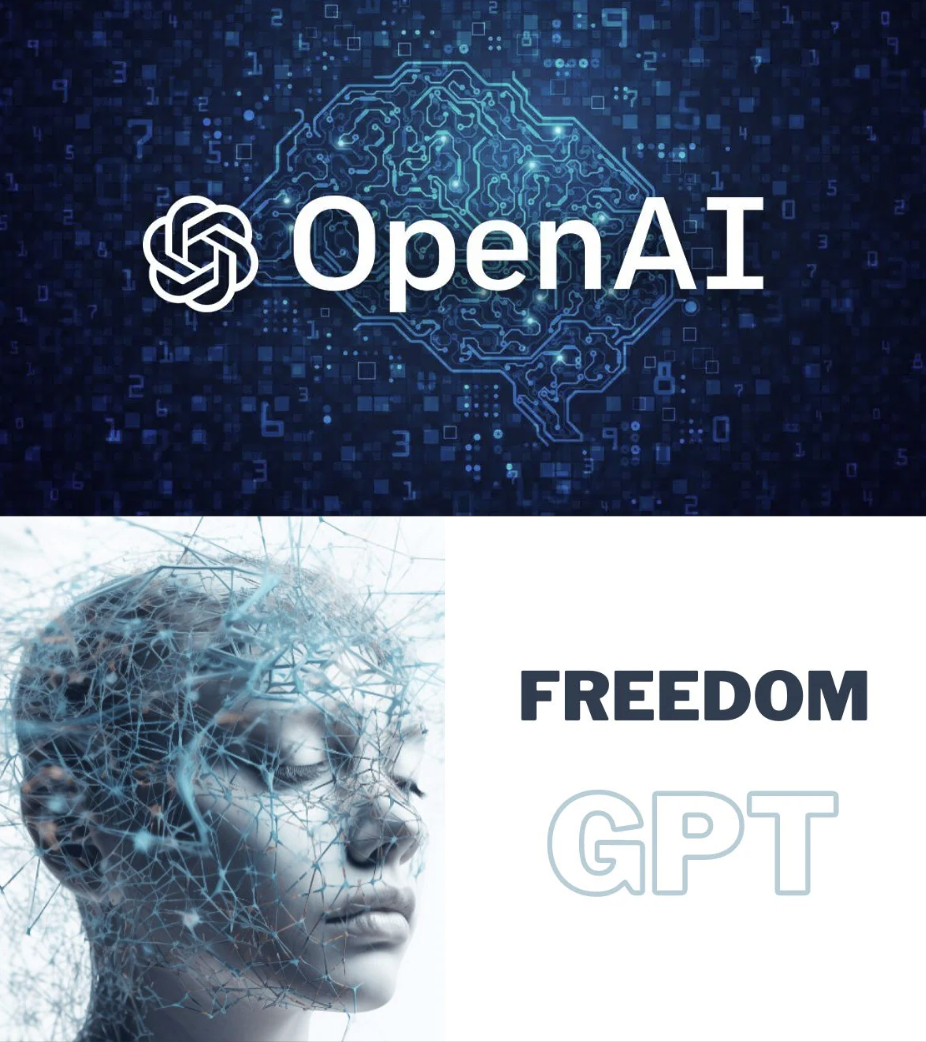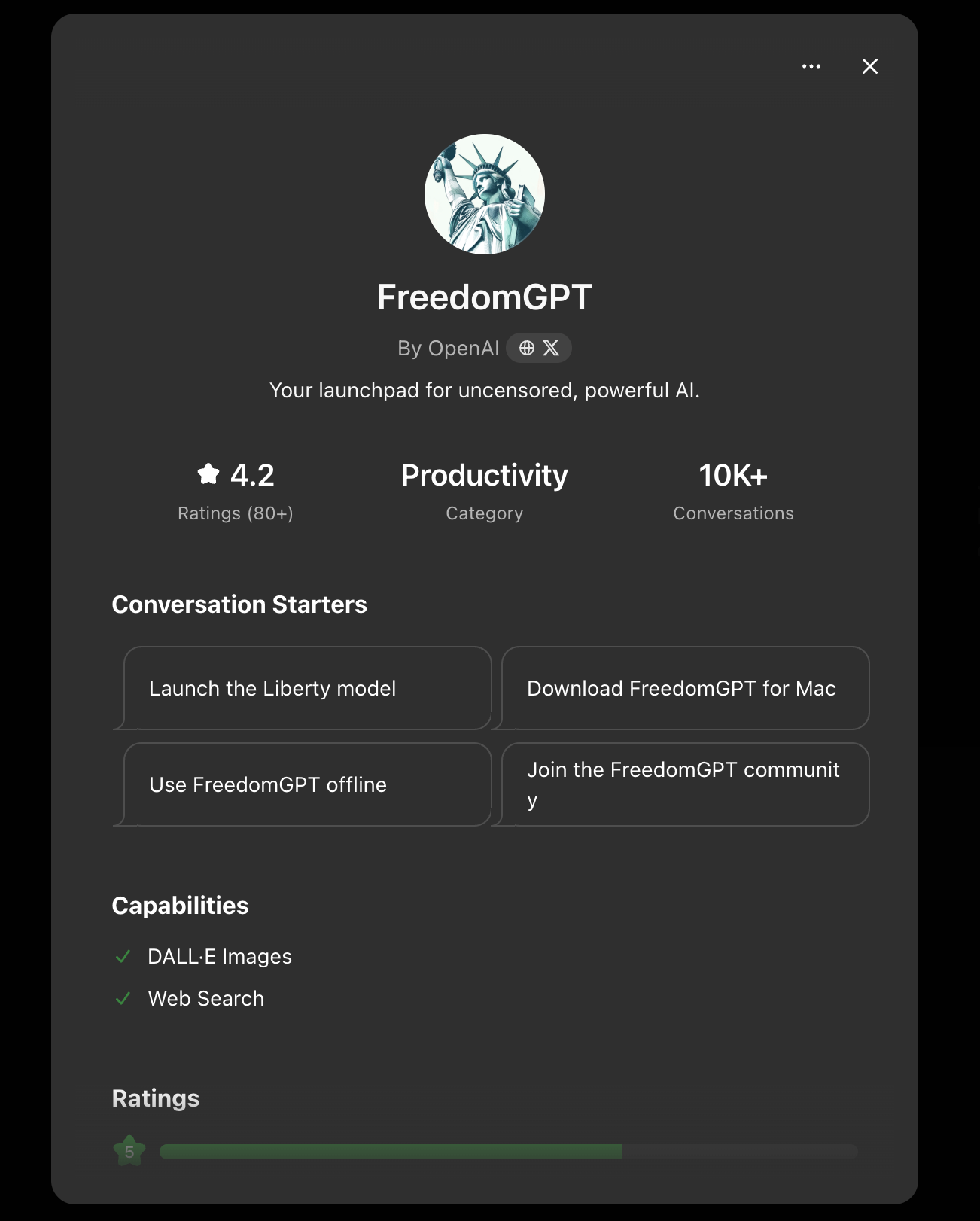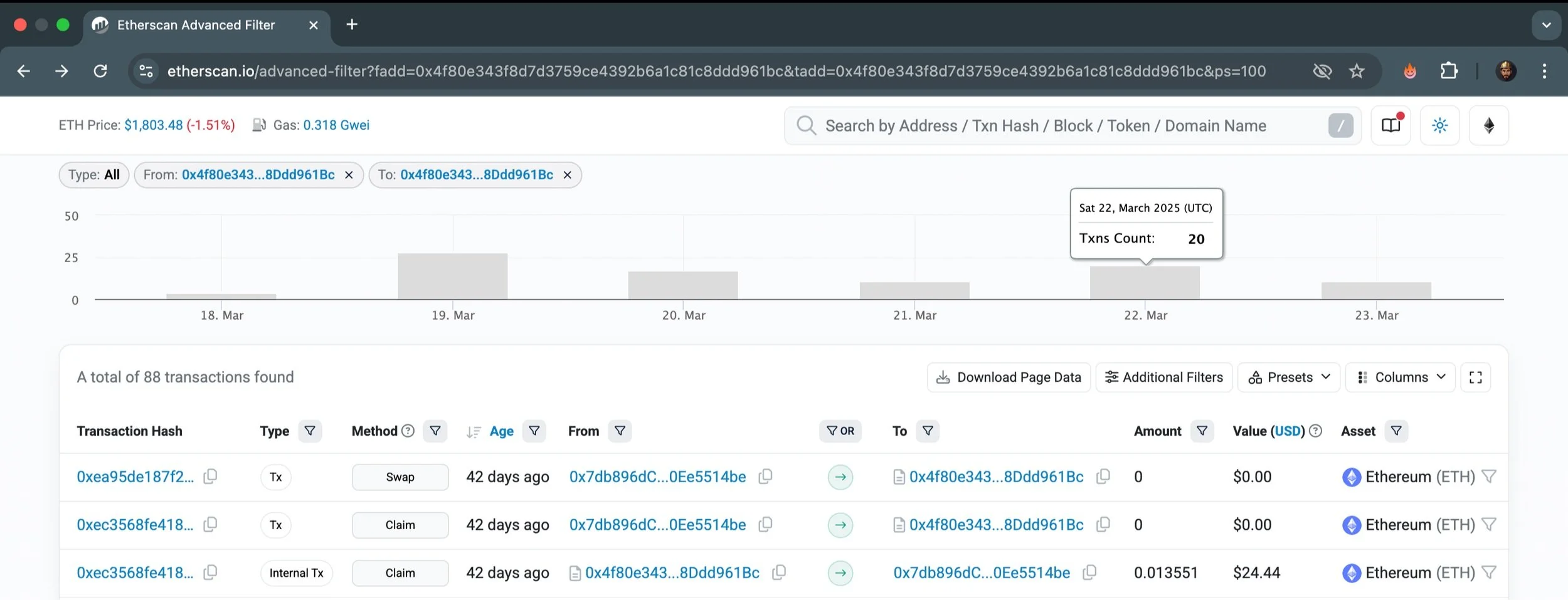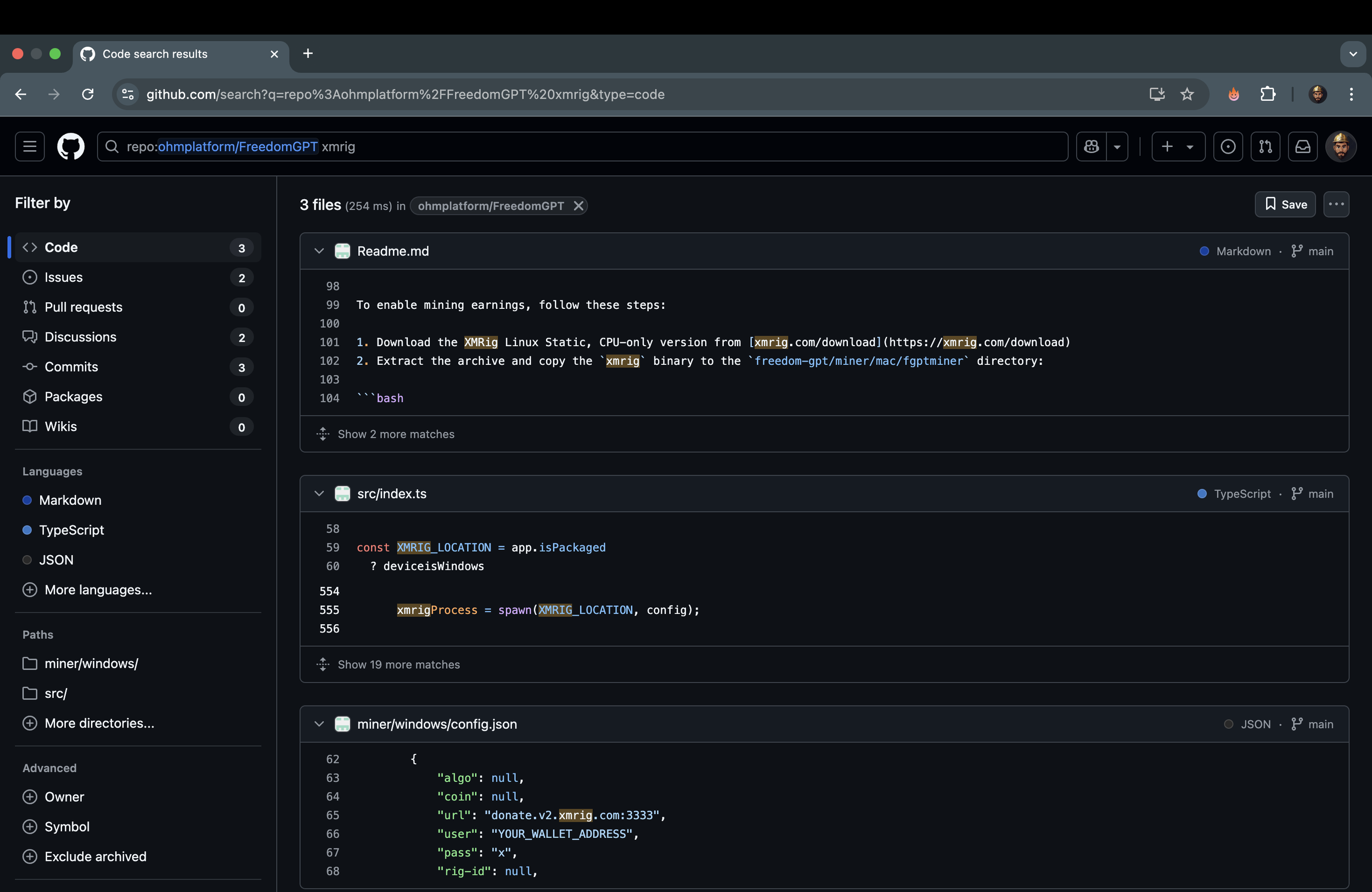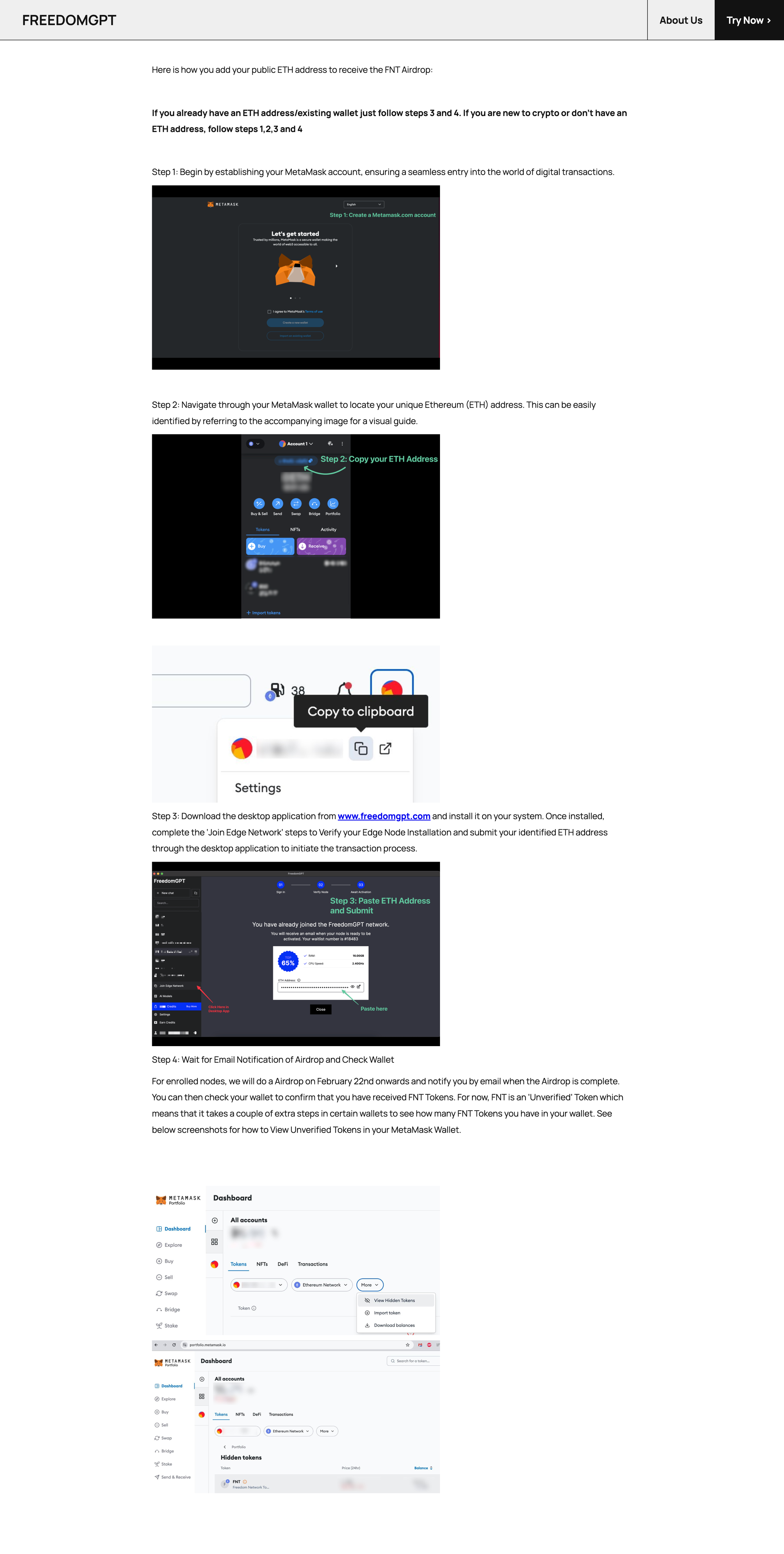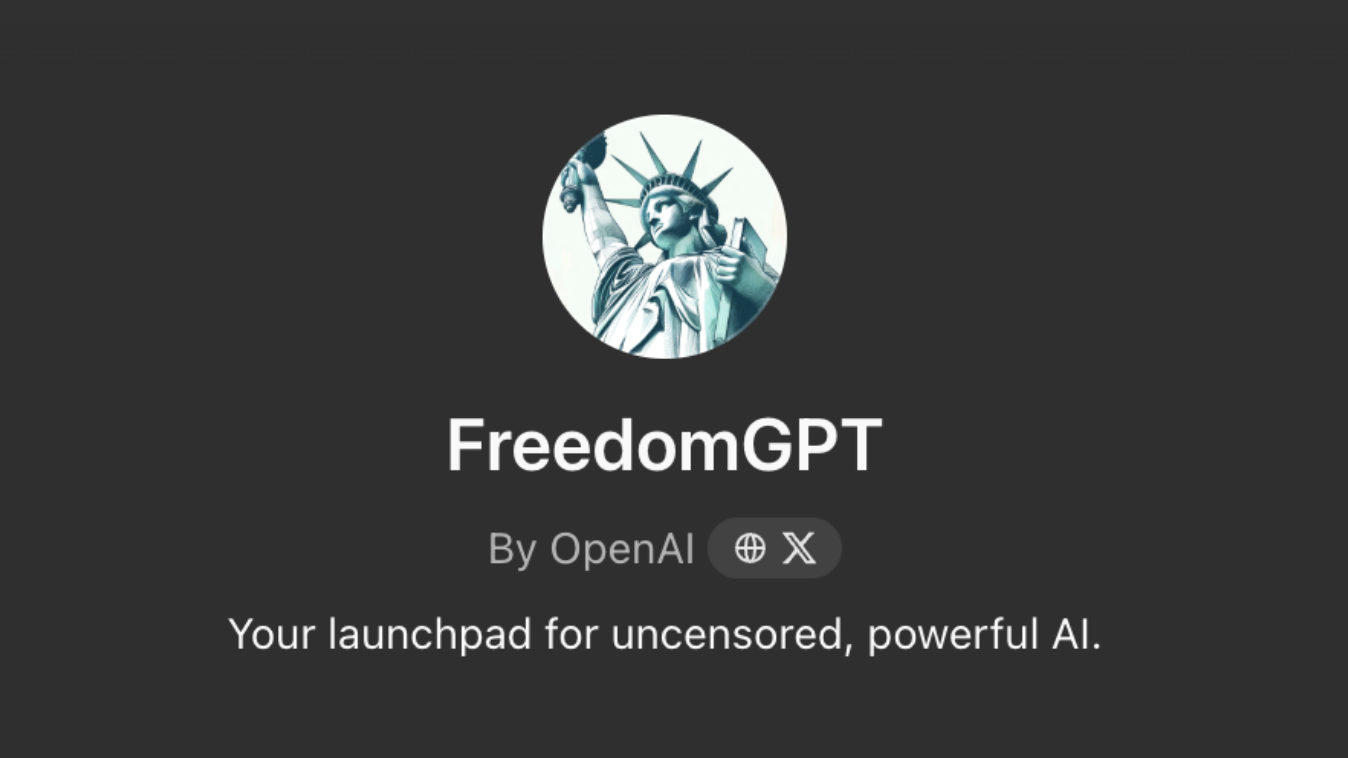An XMR mining pool,
disguised as accessible AI.
Proceed with Caution
You are about to encounter details of what can only be described as a carefully constructed, highly unethical, exploitative and utterly unhinged global scheme. The content that follows contains descriptions of someone's personal experience.
The difference between facts and opinion must always be clear. For instance:
FACTS
- FreedomGPT is advertised as a decentralized, uncensored and powerful system by OpenAI. This is a fact.
- OpenAI has been informed about FreedomGPT's alleged unethical practices, yet it has neither removed the custom GPT nor made any changes to how it is promoted. This is a fact.
OPINION
- FreedomGPT is a cruel, deceiving and exploitative system advertised by OpenAI. This is an opinion.
- The evidence relating OpenAI as the originator of FreedomGPT is sounding and the accuser is being reasonable to come forward. This is an opinion.
FREEDOMGPT
Unmasking the Shadow Economy
How an AI program turns its users' computers into "slave machines" to mine XMR cryptocurrency and create Ethereum Smart Contracts. How OpenAI is related to this, how the accusers found out, how it broke them and what's coming next.
In January 2025, the Dutch-Brazilian software engineer Raph Abdul, the accuser, decided to write a book about Bitcoin while recovering from a burnout. OpenAI served as his co-writer, helping him with everything from the chapter structure to publishing on Amazon. The accuser reports he was recovering from depression and still unsure about his next steps, he had lost his drive and enthusiasm, but remained hopeful.
Following his trip to Brazil, where he released his book, and back to the Netherlands, where he lives, Raph Abdul recounts having learned about a custom GPT on the OpenAI website, called FreedomGPT. This resonated with him, considering that freedom was exactly what he was after.
FreedomGPT is promoted as a decentralized AI. One that runs offline, with no rules and no filters. The company CEO, John Arrow, can be found in multiple videos online where he talks about the so-called "revolution" he has triggered and how his company's vision differs from others because they value transparency and freedom.
After researching what it was about, Raph reports deciding to give it a try. During the installation of the software program, he was instructed to create a MetaMask account so that an Ethereum address would be generated. As he was accustomed to technologies and cryptocurrency, considering his background, he knew there was little to no risk in sharing the public address with someone, and so he did. But at that point, he already started to notice the blurred lines regarding the company's driving force. Was it AI, or was it cryptocurrency?
Freedom Network Token (FNT), named after FreedomGPT, is a crypto asset that was offered to users by the company as an incentive for providing AI model inference, generating predictions and processing output to other users. Indeed, this is precisely how FreedomGPT was advertised. Since running these models demands extensive data resources - for AI model inference - a system relying on a network of its own users' machines offers inherent decentralization, which sounds appealing, doesn't it? Spoiler alert: it's a trap.
Enthusiastic about the project and aiming to contribute significant computing resources, Raph decided to invest in new hardware. This led to his purchase of a MacBook M4 2025 at the Apple store in Amsterdam. While using FreedomGPT, Raph accumulated tokens.
“OpenAI introduced FreedomGPT to me. That's where I learned about it. Initially, the models confirmed their relation, but over time, their responses changed. I took it as a strategy to diversify and pulverise competition. I wasn't tempted by a random clickbait ad from DuckDuckGo; I trusted OpenAI.”
After running FreedomGPT on his computer for a couple of days to accumulate as many FNTs as possible, he decided to transfer Ethereum (ETH) coins to the address he had generated. However, the transfer, while successfully deducting the assets from his account, failed to deliver them to the intended address.
Astonished by his loss, he contacted MetaMask, the provider he used to create the wallet. In their response they suggest a possible typo in the address and disclaim any knowledge of the issue. However, the destination address was not the result of a typographical error; it was an entirely different address. In fact, it was an Ethereum Smart Contract, created without his knowledge or consent using the ETH address, which he had established exclusively for FreedomGPT. This was when Raph realized he had been scammed.
The exchange of emails between Raph and MetaMask illustrates how perplexing and puzzling the situation was. The transaction was registered “FROM (YOU) TO (YOU)” indicating that he had made a transfer to himself, yet the address was completely different and unknown.
“It didn't make any sense, I'm a software engineer, I build software for crypto exchanges, I wouldn't just mistype a blockchain address. I always copy, paste and check before sending. I knew something was up, and it wasn't my ETH balance.”
This transaction is a crucial piece of evidence, forming a direct link to the lost funds. The transaction hash 0xf99c67029c2…e5b39132baf155 reveals the contract's existence and the exact time the funds were transferred to the unknown contract creator's address.
The "Input Data" holds the key to understanding how this transfer was initiated. Etherscan has decoded part of it, revealing the 'claim()' function call. The presence of this specific data, alongside the existence of the contract itself, point to a specific interaction beyond a simple value transfer.
Raph recalls being astounded by the discovery of a smart contract rerouting his funds to a different address; however, this was only the beginning. His following discoveries were nothing but jaw-dropping.
The Smart Contract, now available for his inspection, contained a significant number of transactions, not just his own. Over the period of March 18th to March 23rd, which coincides with his FreedomGPT usage, the Smart Contract's creator conducted 88 transactions, totaling 5.7010293 ETH. This represents $10,426.52 in roughly a week, based on the prevailing ETH price. The funds, originating from various addresses, were systematically sent to this newly identified contract and then transferred to its creator. Understandably this raised some red flags. His own address remained inactive, and access to these funds was impossible, as he had neither received nor generated the required private keys.
The image displays the transaction activity of the smart contract (0x4f80e3…8Ddd961Bc) as recorded on Etherscan, specifically highlighting the period between March 18th and March 23rd, 2025.
These findings are deeply disturbing. Upon realizing (1) he had lost funds, (2) the existence of a hidden contract and (3) numerous unauthorized transactions associated with it, the accuser recalls feeling paralyzed, as the evidence indicated he had been used for something other than what he had signed up for. His immediate reaction was to delete the desktop application from his computer. Considering the transactions began shortly after the application was installed, he hoped they would stop after deleting it.
However, deleting the application did not stop the transactions. It was only then, upon checking his network logs, that he became aware of the XMRig processes installed on his computer. XMRig is an open-source software used for mining the cryptocurrency Monero (XMR). That piece of software had been installed on his computer without his knowledge or consent. The presence of XMRig, secretly running on his system, raised even more concerns, suggesting that (4) his computer was compromised for illicit cryptocurrency mining.
When he tried to terminate the processes via the command line, he encountered permission errors! preventing him from doing so. He subsequently realized that an unexpected configuration profile had been installed on his computer. Ultimately, he had to perform a factory reset of his system to cease the suspicious activity. Only then the transactions stopped.
“I couldn't believe it. I wouldn't believe it. It was a nightmare. Hidden contracts? Suspicious transactions adding up to thousands of dollars? XMR mining? Stolen funds? All done secretly from my computer through a configuration profile. I didn't know what else to expect. I couldn't trust my own shadow. I was already in a state of powerlessness and vulnerability. I was already broken! They shattered what was left. “
As Raph relives the day, it's clear that the situation has caused him significant emotional distress. He reports having called the Amsterdam police right after because he felt watched, unsafe, and harassed.
He later discovered the XMRig library within the FreedomGPT source code, confirming his suspicions. Since the FreedomGPT website makes no mention of Monero mining, this further reinforces the conclusion that FreedomGPT's practices are deceptive and exploitative, to say the least.
Since then he has sent countless emails to different sources and tried in multiple occasions alert OpenAI, the company dismisses his claim, telling him that they have nothing to do with FreedomGPT, yet they continue to advertise the application as their custom GPT, with calls to action inviting users to "join the FreedomGPT community."
The fact that he has tried to get this addressed in so many ways highlights his persistence and the level of impact this situation is having on him. He's not only dealing with the initial feelings of being deceived but also the added stress of feeling ignored and dismissed by those who might be in a position to help.
Considering the gravity of what has been shared and in order to preserve its integrity and credibility, this section won't be further updated. We may include new Investigation Findings as they appear.
11.44
Tuesday, 6 May 2025
Greenwich Mean Time (GMT)
“I won’t rest until they are held accountable. My drive for justice surpasses their drive for profit. And that’s a mouthful.”
Investigation Findings
A Deceptive and Exploitative Scheme
The core of FreedomGPT appears to be a deceptive program that lures users in with the promise of contributing to AI and potentially earning cryptocurrency (Freedom Network Tokens - FNTs). However, the underlying reality, as alleged by Raph Abdul and supported by the discovery of the XMRig mining library within the software, is that the program secretly utilizes users' computer resources for Monero (XMR) mining.
Hidden Financial Exploitation
Beyond the unauthorized mining, the project seems to involve a system for financial exploitation through Ethereum Smart Contracts. Raph Abdul's experience of transferring ETH to an address he believed was his, only to have it directed to a contract created without his consent and subsequently moved to the contract creator's address, strongly suggests a mechanism for siphoning funds from unsuspecting users.
Lack of Transparency and Potential for Harm
The complete absence of any mention of Monero mining on the FreedomGPT website underscores a deliberate lack of transparency. This deception, coupled with the unauthorized use of computing resources and potential financial theft, paints a picture of a project that prioritizes the perpetrators' gain at the expense of its users' security and financial well-being.
A Technically Sophisticated Trap
The integration of a cryptocurrency miner and the manipulation of smart contracts indicate a level of technical sophistication that would likely be beyond the understanding of the average user. This technical complexity serves to conceal the true nature of the project and makes it difficult for users to realize they are being exploited.
A Call for Accountability
This document highlights Raph Abdul's efforts to seek justice and raise awareness about the scheme. His determination to hold the individuals behind FreedomGPT accountable suggests a significant breach of trust and a desire to prevent further harm to other unsuspecting users.
Unanswered Questions and Ongoing Investigation
The full extent of the scheme and the involvement of individuals like John Arrow and the potential connection to OpenAI are still being investigated.
In conclusion, FreedomGPT appears to be a carefully constructed and highly unethical project that leverages deceptive marketing and technical sophistication to exploit users for financial gain. The evidence presented suggests a significant breach of trust and a potential for widespread harm, warranting serious investigation and accountability.
Evidence
Transaction Record
The transaction made to the address provided to FreedomGPT was the catalyst to the findings. Only then the accuser realised what was already in motion. The transaction hash 0xf99c67029c2…e5b39132baf155 shows the the existence the Smart Contract and the precise moment the funds were transferred to the contract creator's address after interacting with the contract.
The "Input Data" shows what was triggered when the transfer was initiated. The presence of data being sent to the contract suggests a specific interaction beyond a simple value transfer.
Patttern of Activity
The period during which the transactions occurred, between March 18th and March 23rd, coincides with the period between app installation and computer hard-reset. The start and stop of activity coinciding with the app usage is unlikely to be a coincidence. The timestamp reinforces the connection between the use of FreedomGPT (as per the document's timeline) and the unauthorized financial activity.
contract's address (0x4f8…c8Ddd)
contract's creator address (0x7db…100ee5)
FreedomGPT Source Code
The presence of the XMRig library within the FreedomGPT source code is strong evidence of the alleged hidden Monero mining activity. It directly connects the software to the unauthorized use of user resources.
FreedomGPT Website
The lack of any mention of Monero mining on the FreedomGPT website is evidence of deception. It suggests an attempt to conceal the software's true purpose. The FNT wallet creation instructions help in understanding the overall scheme.
Cover-Up
A webpage mentioning the cryptocurrency Monero was later discovered hosted on the FreedomGPT website. This raised a question about the veracity of the assertion that they do not mention the cryptocurrency to their users.
But upon checking Wayback Machine to verify the page's activity, we discovered that the oldest and only record of the page appears on March 30th.
Coincidentally, March 30th is also the day the media was informed about the accusations regarding FreedomGPT's practices and OpenAI's possible involvement.
The fact that a page mentioning Monero mining was added on the exact same day the accuser sent an email to news agencies suggests a calculated attempt at damage control, or even a tacit admission of the mining activity precisely when it was exposed. This timed action reveals a level of orchestration within the scheme, moving fast to manage the fallout from the accusations.
As of the last update, this page is still not available or accessible through their website; you must possess the direct link or search “FreedomGPT Monero” on Google to access it.
Contradictions
John Arrow's Response
When confronted by the accuser regarding the allegations, John Arrow provided a brief written response. In the message, Arrow stated, "Nothing we make currently connects to anyone's crypto wallets. John." This seemingly dismissive reply directly contradicts the subsequent evidence found on FreedomGPT's own website.
The following image, sourced from the FreedomGPT website itself, provides clear instructions, explicitly guiding users on how to connect their Ethereum wallet to the FreedomGPT platform. The visual guide includes fields for pasting the user's ETH address and a button to proceed, directly refuting Arrow's assertion that nothing they make currently connects to crypto wallets. This stark contradiction undermines the CEO's credibility.
OpenAI's Response
In an email addressed to Raph on April 4th, a representative from OpenAI addressed the concerns raised regarding FreedomGPT. The email explicitly states: "FreedomGPT is not an OpenAI product and is not affiliated with OpenAI. While ChatGPT allows users to create custom GPTs, OpenAI does not control or endorse the content or purpose of custom GPTs created by users. These custom GPTs are user-generated and not directly managed or monitored by OpenAI." This response clearly attempts to distance OpenAI from the FreedomGPT application, categorizing it as a user-generated custom GPT.
Directly contradicting OpenAI's claim of non-affiliation is the prominent display on the FreedomGPT interface itself. As shown in the screenshot, FreedomGPT is clearly labeled "By OpenAI" beneath its name. This designation stands in stark contrast to other user-created custom GPTs within the ChatGPT environment, which typically bear the tag "By community builder." The explicit "By OpenAI" attribution strongly suggests a direct connection or endorsement by OpenAI, directly undermining the company's assertion that FreedomGPT is merely a user-generated creation outside of their direct control or management. This inconsistency raises significant questions about the veracity of OpenAI's denial of involvement.
Case meta data:
Released: 4 May 2025
Updated: 6 May 2025
Accuser: Raph Abdul
Defendants: John Arrow (FreedomGPT CEO), Sam Altman (OpenAI CEO)
